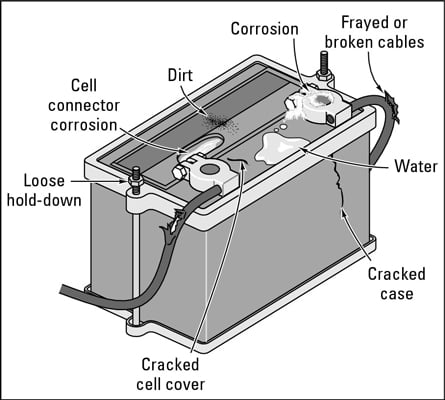How to Check Battery Cables
To check battery cables, visually inspect for corrosion and check for tight connections. Proper maintenance ensures optimal performance and longevity of your vehicle’s electrical system.
It is crucial to regularly check your battery cables to prevent issues such as poor starting or electrical failure. By spending a few minutes examining the cables, you can catch any potential problems early and avoid costly repairs down the line.
In this guide, we will discuss the importance of checking battery cables and provide simple steps to ensure they are in good condition. Follow these steps to keep your vehicle running smoothly and efficiently.
Importance Of Checking Battery Cables
When it comes to vehicle maintenance, checking the battery cables is a crucial yet often overlooked task. The importance of checking battery cables cannot be overstated, as they play a critical role in ensuring proper electrical flow and reliable starting of your vehicle. It is essential to regularly inspect the battery cables for signs of wear and corrosion to prevent potential issues down the road.
Signs Of Battery Cable Problems
There are several signs that may indicate potential problems with your battery cables:
- Corrosion: Visible corrosion or buildup around the cable connections.
- Loose Connections: The cables are not securely connected to the battery terminals.
- Cracks or Fraying: Any visible damage or wear on the cable insulation.
- Poor Electrical Flow: Difficulty starting the vehicle or dimming lights when starting the engine.
The Consequences Of Ignoring Battery Cable Issues
Ignoring battery cable issues can lead to serious consequences:
- Vehicle Failure: Ignoring cable problems may result in unexpected breakdowns or starting issues.
- Electrical Damage: Corroded or damaged cables can cause electrical system malfunctions.
- Safety Risk: Poor electrical connections can lead to safety hazards and potential accidents.
- Costly Repairs: Neglecting cable problems can lead to more extensive and expensive repairs in the future.

Credit: www.dummies.com
Preparing To Check Battery Cables
Before inspecting your battery cables, you need to prepare by gathering the necessary tools and equipment, which includes safety precautions.
Gather The Necessary Tools And Equipment
- Multimeter
- Wire brush
- Safety goggles
- Rubber gloves
Ensure Safety Precautions
- Wear safety goggles and rubber gloves
- Ensure the engine is turned off
- Avoid smoking or open flames nearby
Locate The Battery And Cables
Identify the battery in the engine compartment and trace the cables connected to it, checking for any signs of corrosion or damage.
Steps To Check Battery Cables
Inspect The Battery Cables For Visible Damage
Check for cracks or fraying along the length of battery cables.
Check The Cable Connections
- Ensure the cable connections are securely attached to the battery terminals.
- Look for any signs of corrosion on the connections.
Measure The Cable Resistance
- Use a multimeter to measure the resistance of the cables.
- Compare the measured values against the manufacturer’s specifications.
Test Battery Voltage
Verify the battery voltage using a multimeter to ensure proper power flow.
Fixing Battery Cable Issues
Replacing Damaged Cables
When faced with damaged battery cables, it’s essential to address the issue promptly to ensure the optimal functioning of your vehicle. One common issue to look out for is damaged cables. It is crucial to inspect the battery cables regularly for any signs of wear, such as fraying or exposed wires.
If you notice any damage to the cables, replace them immediately to prevent any risk of electrical shorts or loss of power. Always ensure that the replacement cables match the specifications of the original ones to maintain the integrity of the electrical system in your vehicle.
Repairing Loose Connections
Loose connections can lead to electrical inefficiencies and potential malfunctions. If you come across any loose connections in your battery cables, it’s important to address them promptly.
Tighten the connections using the appropriate tools to ensure a secure and stable electrical connection. This will not only enhance the performance of your vehicle but also prevent any potential safety hazards associated with loose connections.
Cleaning Corroded Cables
Corrosion on battery cables can impede the flow of electricity and hamper the overall performance of the vehicle’s electrical system. Regularly inspect the battery cables for any signs of corrosion and address them promptly to prevent any electrical malfunctions.
Clean the corroded areas using a mixture of baking soda and water, and a wire brush to scrub off the corrosion. Rinse the area with clean water and dry thoroughly. Applying a thin layer of dielectric grease can also help prevent future corrosion and ensure the longevity of the battery cables.
Routine Maintenance For Battery Cables
Battery cable routine maintenance is crucial for ensuring optimal performance. Learn how to check battery cables to prevent any potential issues and ensure a smooth functioning battery.
Routine Maintenance for Battery Cables Proper maintenance of battery cables is essential to ensuring the smooth operation of your vehicle’s electrical system. Neglecting routine maintenance can lead to issues such as poor battery performance and even electrical failure. By regularly cleaning, protecting, inspecting, and testing your battery cables, you can extend their lifespan and avoid potential problems down the road. Cleaning and Protecting Battery Cables Cleaning and protecting your battery cables is a straightforward task that can make a significant difference in their overall performance. Over time, corrosion and buildup can accumulate on the cables, hindering their ability to transfer power effectively. To clean the cables, follow these steps: 1. Start by disconnecting the negative (black) cable, then the positive (red) cable from the battery terminals. This will prevent any accidental electrical shocks or short circuits. 2. Mix a solution of baking soda and water, using a ratio of 1 tablespoon of baking soda to 1 cup of water. Apply this solution to the cables, using a brush or a toothbrush to scrub away any corrosion or debris gently. 3. Rinse the cables with clean water to remove the baking soda solution thoroughly. Ensure that no residue remains on the cables. 4. After the cables are clean and dry, apply a layer of battery terminal protectant to prevent future corrosion. This protectant will create a barrier between the cables and the elements, preserving their functionality. Regularly Inspecting and Testing Cables In addition to cleaning and protecting the battery cables on a routine basis, it’s important to regularly inspect and test them for any signs of wear or damage. This can help identify any potential issues early on and prevent more significant problems from developing. Here’s what you need to do: 1. Inspect the cables thoroughly, checking for any signs of fraying, cracking, or bulging. These can indicate that the cables are worn out and need replacing. 2. Ensure that the cable connections are tight and secure. Loose connections can result in a poor electrical connection and lead to battery issues. 3. Use a multimeter to test the resistance of the cables. Set the multimeter to the ohms setting and touch one probe to each end of the cable. A reading close to zero indicates that the cable is in good condition, while a higher reading may indicate a problem with the cable. 4. If you notice any issues during your inspection or testing, it’s important to address them promptly. This may involve tightening connections, replacing damaged cables, or seeking professional assistance. By incorporating regular cleaning, protecting, inspecting, and testing into your vehicle maintenance routine, you can help prolong the lifespan of your battery cables and maintain optimal electrical performance. Stay proactive and attentive to your battery cables, and they will reward you with reliable and efficient electrical power for years to come.
Credit: www.carparts.com

Credit: m.youtube.com
Frequently Asked Questions On How To Check Battery Cables
How Do I Know If My Battery Cables Are Bad?
To check if your battery cables are bad, look for signs like corrosion, fraying, or loose connections. Test the cables for continuity using a multimeter. If they show high resistance or no continuity, it indicates a problem. Additionally, check for any melted insulation or abnormal smell near the cables.
How Do I Know When To Replace My Battery Cables?
You should replace your battery cables when you notice signs of corrosion, fraying, or loose connections. Regular inspections can help identify issues before they cause problems.
How Do You Check Battery Leads?
To check battery leads, inspect for corrosion, ensure tight connections, test with a multimeter for voltage.
How Do You Check Battery Terminals With A Multimeter?
To check battery terminals with a multimeter, set the multimeter to the DC voltage setting. Connect the red probe to the positive terminal and the black probe to the negative terminal. If the reading is within the specified range, the terminals are in good condition.
How Do You Check Battery Cables For Corrosion?
To check for corrosion on battery cables, inspect them for white or green residue. Clean the cables using a mixture of baking soda and water and a wire brush.
How Often Should Battery Cables Be Replaced?
Battery cables should be replaced every 3-5 years, or as soon as you notice signs of damage or corrosion.
Can Battery Cables Cause A No-start Issue?
Yes, corroded or damaged battery cables can prevent proper electrical connection, resulting in a no-start issue.
Conclusion
Checking battery cables is important for maintaining a vehicle’s electrical system. By following the steps outlined in this blog post, you can identify and address any issues with your battery cables to ensure optimal performance and avoid potential breakdowns. Regular inspection and maintenance of your battery cables will contribute to the overall health and longevity of your vehicle.

